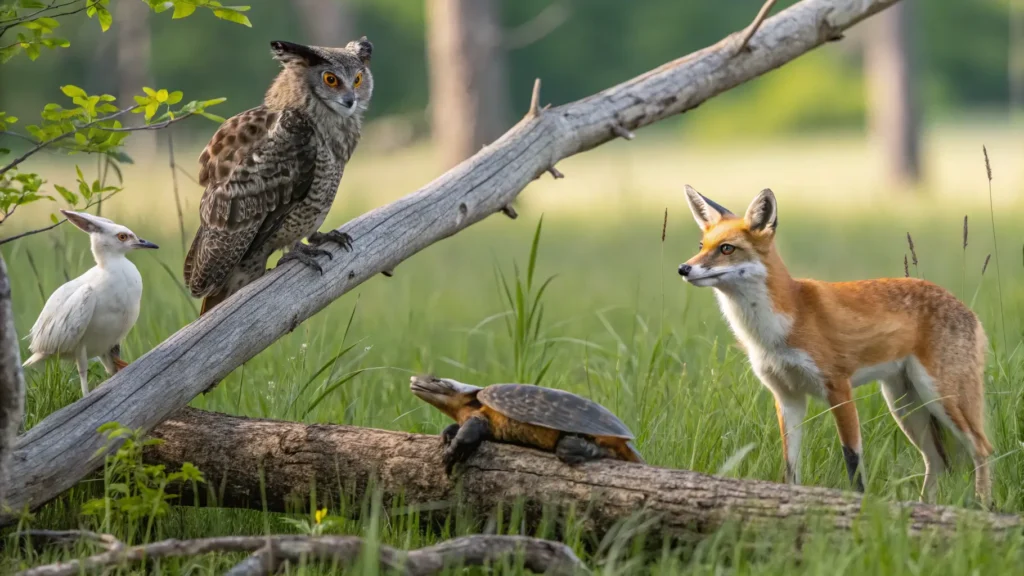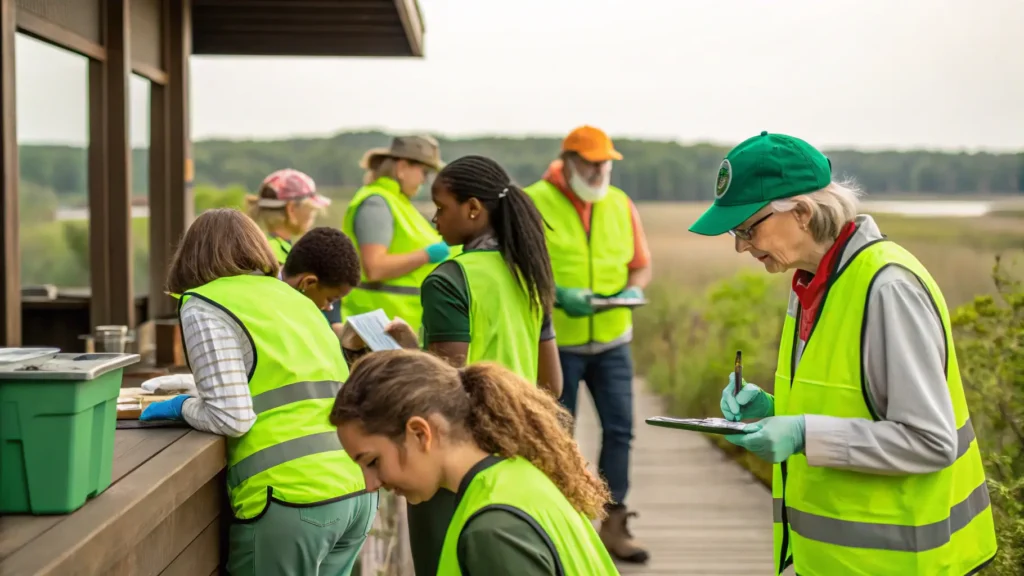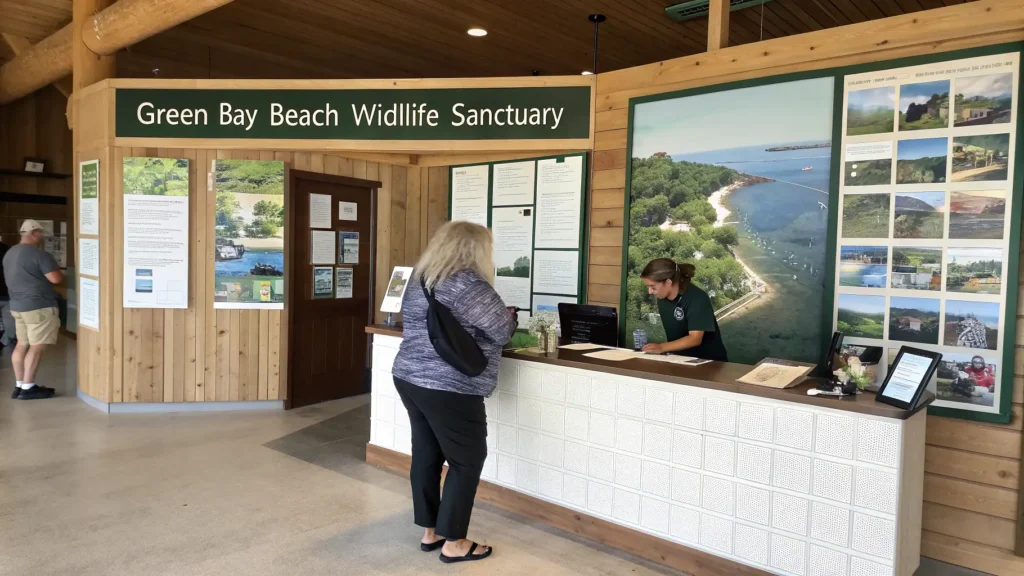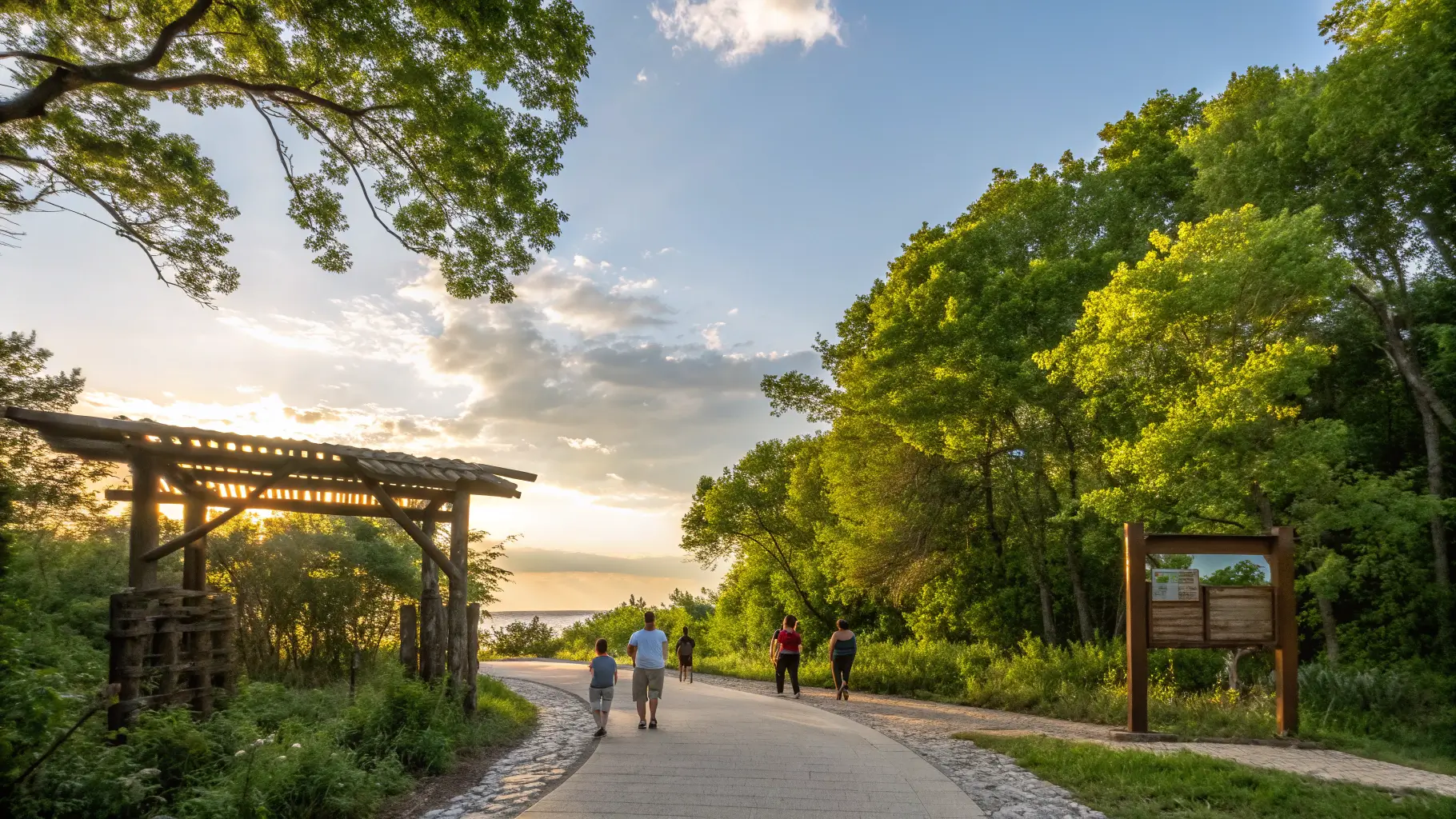Introduction
The Green Bay Bay Beach Wildlife Sanctuary stands as a natural oasis amidst the urban landscape of Green Bay, Wisconsin. This 600-acre urban wildlife refuge offers visitors a unique opportunity to connect with nature, observe diverse wildlife in their natural habitats, and explore miles of scenic trails. Whether you’re a wildlife enthusiast, photographer, family with children, or simply seeking tranquility, the Green Bay Bay Beach Wildlife Sanctuary provides a rejuvenating escape from city life.
What sets this sanctuary apart from typical parks is its dual commitment to wildlife rehabilitation and public education. Home to over 4,500 animals representing more than 200 species, the sanctuary serves as both a haven for injured and orphaned wildlife and an immersive educational resource for the community.
Quick Highlights:
- 600 acres of diverse habitats including woodlands, marshes, and meadows
- Miles of hiking trails for all ability levels
- Year-round wildlife viewing opportunities
- Free admission (donations appreciated)
- Educational exhibits and interactive programming
- Wildlife rehabilitation facilities
Table of Contents
History & Mission
The Green Bay Bay Beach Wildlife Sanctuary’s story began in 1936 when the City of Green Bay set aside land as a refuge for waterfowl. What started as a small game farm has evolved into one of Wisconsin’s most treasured wildlife rehabilitation and education centers.
During the Great Depression, the Works Progress Administration (WPA) developed the initial infrastructure, creating ponds and constructing the first buildings. Over the decades, the sanctuary expanded its mission beyond simply providing habitat for waterfowl to becoming a comprehensive wildlife rehabilitation center.
The sanctuary’s transformation accelerated in the 1970s when a dedicated group of community members formed the Friends of the Wildlife Sanctuary, a non-profit organization that continues to support the sanctuary’s operations and expansion today.
Mission Statement: “To provide a refuge for injured, orphaned, and threatened wildlife while offering educational opportunities that inspire appreciation and responsible stewardship of the natural world.”
This mission drives every aspect of the sanctuary’s operations, from wildlife care to educational programming. Unlike many wildlife refuges that focus solely on habitat preservation, the Green Bay Bay Beach Wildlife Sanctuary actively rehabilitates approximately 6,000 animals annually, making it one of the largest wildlife rehabilitation centers in Wisconsin.
Planning Your Visit (The Essentials)

Location & Directions
The Green Bay Bay Beach Wildlife Sanctuary is located at 1660 East Shore Drive, Green Bay, WI 54302. Nestled on the east side of the city, the sanctuary is easily accessible from major highways.
By Car:
- From Highway 43: Take the Webster Avenue exit and head north. Turn right on East Shore Drive. The sanctuary entrance will be on your right.
- From Highway 41: Take the Mason Street exit and head east. Turn left on Webster Avenue, then right on East Shore Drive.
Public Transportation: Green Bay Metro Transit provides bus service to the sanctuary via Route 4. The bus stop is located at the main entrance.
Parking: Free parking is available in several lots throughout the sanctuary. The main lot near the Nature Center offers the most convenient access to the sanctuary’s central attractions.
Hours of Operation
The Green Bay Bay Beach Wildlife Sanctuary grounds are open daily from 8:00 AM to 4:30 PM year-round, including holidays.
Nature Center Hours:
- Monday – Friday: 8:00 AM – 4:30 PM
- Saturday: 9:00 AM – 4:00 PM
- Sunday: Closed (grounds remain open)
Observation Building Hours:
- Daily: 9:00 AM – 4:00 PM
Seasonal Variations: During summer months (Memorial Day through Labor Day), the Nature Center extends its hours until 6:00 PM on weekdays and is open from 9:00 AM – 5:00 PM on Sundays.
Admission Fees
One of the most remarkable aspects of the Green Bay Bay Beach Wildlife Sanctuary is that it remains free to the public. This accessibility aligns with the sanctuary’s mission to provide educational opportunities for all community members regardless of economic status.
While there is no admission fee, donations are greatly appreciated and help support the sanctuary’s wildlife rehabilitation efforts and educational programs. Donation boxes are located throughout the sanctuary, particularly in the Nature Center.
Suggested Donations:
- Adults: $5
- Children: $3
- Families: $15
Accessibility Information
The Green Bay Bay Beach Wildlife Sanctuary is committed to making nature accessible to all visitors:
- The Nature Center features wheelchair-accessible entrances, restrooms, and exhibits
- Paved trails throughout the central portion of the sanctuary accommodate wheelchairs and strollers
- Several wildlife viewing platforms are wheelchair accessible
- Tactile exhibits in the Nature Center cater to visitors with visual impairments
- Service animals are permitted throughout the sanctuary
- Free wheelchair loans are available at the Nature Center (limited availability, call ahead)
For visitors with specific accessibility needs, the sanctuary staff recommends calling ahead at (920) 391-3671 to ensure the most comfortable experience. For more on accessibility standards in public outdoor spaces, see the U.S. Access Board’s guidelines.
Facilities
Visitor Center: The Nature Center serves as the sanctuary’s hub, offering educational exhibits, a gift shop, restrooms, and information about daily activities.
Restrooms: Located in the Nature Center, Observation Building, and at strategic points along the main trails.
Gift Shop: The Nature’s Corner Gift Shop in the Nature Center offers wildlife-themed merchandise, books, educational toys, and locally made crafts. All proceeds support the sanctuary’s operations.
Picnic Areas: Several designated picnic areas with tables are available throughout the sanctuary. The main picnic area, located near the playground, features covered pavilions.
Playground: A nature-themed playground provides entertainment for younger visitors.
Observation Decks: Multiple wildlife viewing platforms overlook ponds and natural habitats.
What to Bring
To maximize your experience at the Green Bay Bay Beach Wildlife Sanctuary, consider bringing:
- Binoculars: Enhance your wildlife viewing experience
- Camera: Capture memorable moments with wildlife and nature
- Weather-appropriate clothing: Dress in layers, as temperatures can vary throughout the sanctuary
- Comfortable walking shoes: Many trails feature natural surfaces
- Water bottle: Stay hydrated, especially during summer months
- Insect repellent: Particularly important during warmer months
- Sunscreen: Many areas have limited shade
- Field guide: Enhance your wildlife identification skills
Rules & Regulations
To protect both wildlife and visitors, please observe these important guidelines:
- Stay on designated trails to minimize habitat disturbance
- Do not feed the wildlife as human food can be harmful
- Maintain a safe distance from all animals
- Keep pets at home (service animals excepted)
- No smoking anywhere within the sanctuary
- No collecting plants, animals, or natural materials
- Bicycles and scooters are not permitted on trails
- No drones without prior permission
- Quiet voices help you see more wildlife
Main Attractions & Things to Do
Wildlife Viewing
The Green Bay Bay Beach Wildlife Sanctuary provides exceptional wildlife viewing opportunities throughout the year. The sanctuary’s diverse habitats attract a wide variety of native Wisconsin wildlife.
Best Wildlife Viewing Areas:
- Woodland Building: Houses native Wisconsin mammals including foxes, wolves, and bobcats in naturalistic enclosures.
- Raptor Exhibit: Features permanent resident birds of prey that cannot be released due to injuries.
- Waterfowl Ponds: Home to numerous species of ducks, geese, swans, and other water birds.
- Bird Viewing Room: Climate-controlled room with one-way glass overlooking feeding stations.
- Muskrat Lodge Observation Deck: Offers glimpses of muskrats, beavers, and other wetland wildlife.
Wildlife Viewing Tips:
- Visit early morning or late afternoon when animals are most active
- Move slowly and quietly along trails
- Bring binoculars for distant viewing
- Wear earth-toned clothing to blend with surroundings
- Check with staff about recent wildlife sightings
Nature Center & Exhibits
The R. A. Meijer Nature Center serves as the sanctuary’s educational hub, featuring interactive exhibits that highlight Wisconsin’s diverse ecosystems.
Permanent Exhibits Include:
| Exhibit | Description |
|---|---|
| Wisconsin Habitats | Life-sized dioramas depicting woodland, prairie, and wetland ecosystems |
| Wildlife Rehabilitation | Behind-the-scenes look at the sanctuary’s rehabilitation efforts |
| Sensory Discovery Area | Hands-on activities for children to explore nature through touch, smell, and sound |
| Live Animal Encounters | Rotating display of ambassador animals and rehabilitation patients |
| Conservation History | Timeline of conservation efforts in Wisconsin |
The Nature Center also houses a small auditorium where educational presentations, films, and workshops are regularly scheduled.
Hiking Trails
The Green Bay Bay Beach Wildlife Sanctuary maintains over 6 miles of trails that wind through various habitats, offering visitors intimate encounters with nature.
Main Trail System:
- Woodland Trail (1.2 miles): Moderate difficulty, explores mature forest habitat
- Wetland Loop (0.8 miles): Easy, boardwalk trail through marsh habitat
- Prairie Path (1 mile): Easy to moderate, open meadow with seasonal wildflowers
- Wildlife Way (0.5 miles): Fully paved, accessible trail connecting main attractions
- Fox Trail (1.5 miles): Moderate difficulty, follows East River shoreline
- Observation Loop (0.3 miles): Easy, provides views of main waterfowl ponds
Trail maps are available at the Nature Center and major trailheads throughout the sanctuary.
Educational Programs & Workshops
The Green Bay Bay Beach Wildlife Sanctuary offers a robust calendar of educational programs for visitors of all ages: Environmental education helps build public support for conservation efforts and improves ecological literacy. For more, explore EPA resources on environmental education.
Regular Programs:
- Daily wildlife presentations (summer season)
- Weekend naturalist-led hikes
- Monthly wildlife photography workshops
- Wildlife rehabilitation demonstrations
- Seasonal nature crafts workshops
School Programs: The sanctuary offers curriculum-based education programs for K-12 students, focusing on wildlife conservation, habitat preservation, and environmental stewardship.
Special Interest Programs:
- Master Naturalist certification courses
- Wildlife tracking workshops
- Bird identification classes
- Native plant gardening seminars
Program schedules and registration information are available on the sanctuary’s website or at the Nature Center.
Photography Hotspots
The Green Bay Bay Beach Wildlife Sanctuary provides photographers with countless opportunities to capture stunning wildlife and landscape images.
Top Photography Locations:
- Muskrat Lodge Observation Deck: Perfect for waterfowl and wetland photography
- Raptor Exhibit: Close-up opportunities with birds of prey
- Prairie Lookout: Sweeping vistas especially beautiful during sunset
- Wood Duck Pond: Morning mist creates magical atmosphere
- Woodland Spring: Wildflowers and forest scenes
- Butterfly Garden: Macro photography opportunities (summer)
Photography Tips:
- Early morning light provides the best illumination for wildlife
- Bring a telephoto lens for wildlife shots
- Consider a tripod for low-light conditions
- Check with staff about recent wildlife activity
- Participate in one of the sanctuary’s photography workshops
Observation Tower
The 50-foot observation tower provides panoramic views of the sanctuary and surrounding area. Located near the Nature Center, this tower offers visitors a unique perspective of the sanctuary’s diverse habitats.
From this vantage point, visitors can observe:
- The sanctuary’s network of ponds and wetlands
- Distant views of Green Bay
- Migrating birds during spring and fall seasons
- The urban-wildlife interface that makes the sanctuary so unique
The tower features educational placards that help visitors identify landmarks and understand how the sanctuary’s habitats are interconnected.
Special Events
The Green Bay Bay Beach Wildlife Sanctuary hosts numerous special events throughout the year that enhance the visitor experience and support the sanctuary’s mission:
Annual Events:
- Wildlife Baby Shower (Spring): Educational event about wildlife babies and rehabilitation
- Walk for Wildlife (Summer): Fundraising walk supporting rehabilitation efforts
- Fall Family Festival (Autumn): Celebration of autumn with nature activities
- Winter Wildlife Weekend (Winter): Focus on winter adaptations of Wisconsin wildlife
Monthly Events:
- Full moon hikes
- Conservation lectures
- Wildlife photography contests
- Volunteer recognition programs
For a complete calendar of upcoming events, check the sanctuary’s website or inquire at the Nature Center.
The Wildlife

Key Bird Species
The Green Bay Bay Beach Wildlife Sanctuary is renowned for its bird diversity, with over 230 species recorded within its boundaries. This remarkable diversity makes it a premier destination for birdwatchers in the Midwest. Wisconsin’s varied landscapes make it a hotspot for birdwatching. The Wisconsin Society for Ornithology provides resources, maps, and birding events throughout the state.
Year-Round Residents:
| Species | Best Viewing Location | Notes |
|---|---|---|
| Bald Eagle | Fox Trail | Nesting pair visible from observation platform |
| Great Horned Owl | Woodland Trail | Listen for hooting at dusk |
| Pileated Woodpecker | Mature forest areas | Look for rectangular holes in trees |
| Northern Cardinal | Feeding stations | Abundant throughout the sanctuary |
| Black-capped Chickadee | Woodland edges | Often approach humans closely |
Notable Seasonal Visitors:
| Species | Season | Best Viewing Location |
|---|---|---|
| Sandhill Crane | Spring/Fall | Wetland Loop |
| Wood Duck | Spring/Summer | Wood Duck Pond |
| Scarlet Tanager | Summer | Woodland Trail |
| Indigo Bunting | Summer | Prairie Path |
| Snow Bunting | Winter | Open fields |
Bird Photography Tips:
“Morning light at the main pond creates perfect conditions for photographing waterfowl. Position yourself with the sun at your back and wait patiently. The birds will eventually accept your presence and return to their natural behaviors.” – Local wildlife photographer
Mammals You Might See
The sanctuary provides habitat for numerous mammal species, from small rodents to larger predators:
Common Mammals:
- White-tailed Deer
- Red Fox
- Eastern Gray Squirrel
- Fox Squirrel
- Eastern Chipmunk
- Muskrat
- Beaver
- Eastern Cottontail
- Raccoon
- Mink
Rehabilitation Residents: The sanctuary houses several permanent mammal residents that cannot be released due to injuries or habituation. These ambassador animals include wolves, bobcats, and foxes, providing visitors with unique opportunities to observe these typically elusive species.
Reptiles & Amphibians
The sanctuary’s wetlands and woodlands provide ideal habitat for a variety of reptiles and amphibians:
Reptiles:
- Snapping Turtle
- Painted Turtle
- Garter Snake
- Northern Water Snake
- Fox Snake
Amphibians:
- American Toad
- Spring Peeper
- Green Frog
- Leopard Frog
- Blue-spotted Salamander
The Nature Center features several educational exhibits with live reptiles and amphibians, allowing visitors to observe these fascinating creatures up close.
The Importance of Habitat
The Green Bay Bay Beach Wildlife Sanctuary showcases the critical relationship between wildlife and habitat through its ecosystem preservation efforts:
Habitat Types Preserved:
- Mature hardwood forest
- Wetlands and ponds
- Tallgrass prairie
- Riparian corridors
- Meadows
The sanctuary actively manages these habitats to maximize biodiversity through:
- Controlled burns in prairie areas
- Invasive species removal
- Native plant restoration
- Wetland enhancement
- Nest box programs for birds and mammals
Educational signage throughout the sanctuary explains how these conservation practices benefit wildlife and how visitors can apply similar principles to their own properties.
Seasonal Highlights
Spring (March-May)
Spring transforms the Green Bay Bay Beach Wildlife Sanctuary into a hub of activity:
- Wildlife: Migratory birds return, waterfowl courtship displays, emergence of amphibians
- Flora: Wildflower blooms including trillium, hepatica, and marsh marigold
- Activities: Bird migration tours, frog call identification walks, spring wildflower hikes
- Special Events: Earth Day celebration, wildlife baby shower fundraiser
“Spring at the sanctuary is a symphony of sounds – from the chorus of frogs to the melodies of returning warblers. It’s a time of renewal that shouldn’t be missed.” – Sanctuary Naturalist
Summer (June-August)
Summer brings lush growth and abundant wildlife activity:
- Wildlife: Nesting birds, fawns, turtle hatchlings, butterfly abundance
- Flora: Prairie wildflowers, aquatic plants in full bloom
- Activities: Summer day camps, butterfly identification walks, photography workshops
- Special Events: Walk for Wildlife fundraiser, evening concerts, night hikes
Summer also brings the highest visitor numbers, so arriving early in the day is recommended for a more peaceful experience.
Fall (September-November)
Autumn transforms the sanctuary with vibrant colors and migration activity:
- Wildlife: Bird migration, deer rutting season, squirrel food caching
- Flora: Spectacular fall foliage, especially along the Woodland Trail
- Activities: Fall color hikes, wildlife preparation for winter programs
- Special Events: Fall Festival, harvest moon hikes, Halloween-themed nature programs
The sanctuary’s maple, oak, and aspen trees create a spectacular autumn display that attracts visitors from throughout the region.
Winter (December-February)
Winter offers a serene landscape and unique wildlife viewing opportunities:
- Wildlife: Snow-tracking mammals, winter bird residents, deer herds
- Flora: Evergreen identification, winter tree identification
- Activities: Snowshoeing (equipment rentals available), winter tracking workshops
- Special Events: Winter Wildlife Weekend, holiday nature crafts, owl prowls
The sanctuary grooms several trails for winter hiking, and the heated observation building provides a comfortable environment for winter wildlife watching.
For Families & Kids
The Green Bay Bay Beach Wildlife Sanctuary offers numerous family-friendly features that make it an ideal destination for visitors of all ages:
Kid-Friendly Attractions:
- Nature-themed playground near the picnic area
- Touch tables in the Nature Center with animal artifacts
- Kid-height viewing windows in the observation building
- “Wildlife Detective” self-guided activity booklets (available at the Nature Center)
- Stroller-friendly paved paths around the main pond
Family Programs:
- “Wildlife Wonders” (ages 3-5) – 45-minute guided explorations
- “Junior Naturalist” (ages 6-10) – hands-on nature activities
- “Family Nature Night” – monthly evening programs for families
- “Critter Connection” – weekend meet-and-greets with ambassador animals
Tips for Families:
- The Wildlife Way trail (0.5 miles) is ideal for families with young children
- Pack snacks and water, especially during summer months
- Visit the Nature Center first to pick up family activity guides
- Morning visits typically offer better wildlife viewing and cooler temperatures
- Check the daily schedule for feeding times and demonstrations
Conservation Efforts

The Green Bay Bay Beach Wildlife Sanctuary stands at the forefront of wildlife conservation in northeastern Wisconsin through its various initiatives:
Wildlife Rehabilitation: The sanctuary operates one of the state’s largest wildlife rehabilitation centers, treating approximately 6,000 injured, orphaned, or sick wild animals annually. The rehabilitation facility includes:
- Specialized care units for different species
- Medical treatment rooms
- Outdoor pre-release enclosures
- Specialized diets prepared on-site
Habitat Restoration: The sanctuary actively restores native habitats through:
- Removal of invasive plant species
- Native plant reintroduction
- Wetland creation and enhancement
- Forest management for wildlife diversity
Research Contributions: Staff and volunteers contribute to scientific knowledge through:
- Bird banding programs
- Population monitoring
- Migration studies
- Wildlife disease surveillance
Conservation Education: The sanctuary reaches over 30,000 students annually through its educational programs, fostering the next generation of environmental stewards.
Volunteering & Support
The Green Bay Bay Beach Wildlife Sanctuary relies heavily on community support to fulfill its mission:
Volunteer Opportunities:
- Wildlife rehabilitation assistants
- Trail maintenance crews
- Educational program assistants
- Special event volunteers
- Administrative support
- Wildlife monitoring
Volunteers contribute over 15,000 hours annually, equivalent to more than seven full-time staff positions.
How to Become a Volunteer:
- Attend a volunteer orientation session (held monthly)
- Complete a volunteer application
- Participate in specific training for your area of interest
- Commit to a regular schedule (varies by position)
Financial Support: The sanctuary welcomes donations in various forms:
- Annual membership in the Friends of the Wildlife Sanctuary
- One-time donations
- “Adopt an Animal” sponsorship program
- Memorial and tribute gifts
- Planned giving options
- Corporate sponsorships
Membership Benefits:
- Quarterly newsletter
- Discounts on programs and merchandise
- Invitations to member-only events
- Reciprocal admission to partner organizations
- Tax deduction for contribution portion
Nearby Attractions & Amenities
Extend your visit to the Green Bay Bay Beach Wildlife Sanctuary by exploring these nearby attractions:
Within 5 Miles:
- Bay Beach Amusement Park (adjacent to sanctuary)
- Neville Public Museum
- Fox River State Trail
- Green Bay Botanical Garden
- NEW Zoo & Adventure Park
Dining Options:
- The Depot Café (5-minute drive)
- Kroll’s East (traditional Wisconsin supper club, 7-minute drive)
- Kavarna Coffeehouse (10-minute drive)
- Titletown Brewing Company (15-minute drive)
Accommodations:
- Lodge Kohler (luxury option, 15-minute drive)
- Hampton Inn Green Bay Downtown (mid-range, 10-minute drive)
- Comfort Suites Green Bay (family-friendly, 12-minute drive)
- Astor House Bed & Breakfast (historic option, 8-minute drive)
Additional Outdoor Experiences:
- Fox River Trail (hiking, biking)
- Bay Beach Park (swimming, picnicking)
- Brown County Reforestation Camp (hiking, mountain biking)
- Barkhausen Waterfowl Preserve (birdwatching)

Frequently Asked Questions
Q: Is there an admission fee for the Green Bay Bay Beach Wildlife Sanctuary?
No, the sanctuary is free to all visitors, though donations are appreciated and help support wildlife rehabilitation efforts.
Q: Can I bring my dog to the sanctuary?
No, pets are not allowed in order to protect the sanctuary’s wildlife. Service animals are permitted.
Q: How long should I plan to spend at the sanctuary?
Most visitors spend 2-3 hours exploring the main attractions. For a comprehensive experience, allow 4-5 hours.
Q: Does the sanctuary close during winter?
No, the sanctuary remains open year-round, though some trails may be inaccessible during heavy snow events.
Q: Are there food options available at the sanctuary?
The sanctuary does not have a restaurant, but picnic areas are available for visitors who bring their own food. Vending machines with snacks and beverages are located in the Nature Center.
Q: What should I do if I find an injured wild animal?
Contact the sanctuary’s wildlife rehabilitation department at (920) 391-3685 for guidance. Do not attempt to care for injured wildlife yourself.
Q: Are guided tours available?
Yes, guided tours can be arranged for groups of 10 or more with advance reservation. Individual visitors can join regularly scheduled naturalist-led hikes on weekends.
Q: Is the sanctuary wheelchair accessible?
Many areas of the sanctuary are accessible, including the Nature Center, Observation Building, and paved trails around the main pond. Some natural surface trails may not be suitable for wheelchairs.
Visitor Reviews & Testimonials
“We visit the Green Bay Bay Beach Wildlife Sanctuary at least once each season. It’s amazing how the landscape transforms throughout the year. Our children have grown up watching the sanctuary’s rescued animals and learning about Wisconsin’s wildlife.” – Lisa T., Green Bay resident
“As a wildlife photographer, I find endless inspiration at this sanctuary. The staff are knowledgeable about recent sightings and always willing to point visitors in the right direction. I’ve captured some of my best bird photos right here in the heart of Green Bay.” – Michael S., Wildlife Photographer
“The rehabilitation work being done here is truly remarkable. During our visit, we were able to witness the release of a rehabilitated red-tailed hawk. It was a powerful moment that demonstrated the sanctuary’s commitment to wildlife conservation.” – The Johnson Family, Milwaukee
“Don’t miss the observation tower! The panoramic views of the sanctuary’s diverse habitats give you a whole new perspective on this urban wildlife refuge.” – TravelWisconsin.com review
The Green Bay Bay Beach Wildlife Sanctuary represents the perfect balance between wildlife rehabilitation, conservation, and public education. This urban oasis provides not only a sanctuary for wildlife but also a place where people of all ages can connect with nature and develop a deeper appreciation for Wisconsin’s natural heritage. Whether you’re seeking a peaceful nature walk, an educational family outing, or a chance to photograph diverse wildlife, the sanctuary offers something for everyone throughout the year.
By supporting the sanctuary through your visit, donations, or volunteer time, you contribute to the vital work of wildlife conservation and environmental education in northeastern Wisconsin.
This comprehensive guide was last updated in May 2025. While we strive to provide accurate information, hours, programs, and other details may change. Please check the sanctuary’s official website or call (920) 391-3671 for the most current information before your visit.


